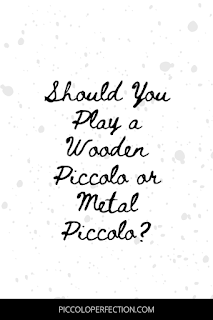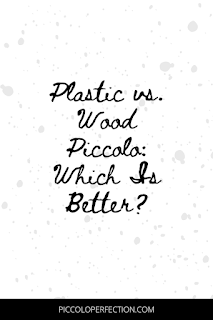Wooden Piccolo vs. Metal: Which Is Better?
Are you looking for your first piccolo or an upgrade? Consider the difference between a metal and wooden piccolo.
Both materials have unique advantages and disadvantages. So don't write off either option until you compare the two.
Before we get into the pros and cons, this post contains affiliate links. Click here to read the full disclosure policy.
Pros of Wooden Piccolos
If you ask a group of piccolo players about the type of piccolo they play, a lot of them will probably say wood. Like other woodwinds (clarinets, oboes, bassoons), most professional piccolos are wood.
That is part of how the name "woodwind" originated. Even older flutes were made of wood. But regardless of the professional status, wooden piccolos offer a few benefits.
Warm Sound
When you play in an orchestra or band, you can blend a lot more easily on a wooden instrument. Metal piccolos tend to be pretty shrill, so blending is more difficult.
As a piccolo player, I've had to blend with flutes, clarinets, and even brass instruments. I find it much easier to blend on a wooden instrument than one made of metal.
Even when playing alone, a wooden piccolo sounds a lot warmer. People already have a vendetta against the piccolo, so I don't want to give them more reasons to hate the sound.
Different Woods
Grenadilla is by far the most common wood used to make piccolos. It offers that warm sound you want to blend with others or play a solo.
However, you can also find piccolos made of other woods, like cocus wood. Piccolo headjoints are available in even more woods, such as quebracho, olivewood, and mopane.
Each wood can offer a slightly different tone quality. So when you're ready to upgrade to a wooden piccolo or headjoint, you can shop around to find a combination you like.
Headjoint Cuts
Another benefit of wooden piccolos is that you can (usually) choose between two or more headjoint cuts. Like on the flute, the piccolo headjoint cut can affect your sound and ease of playing.
Many piccolos offer a traditional cut, which is small and round. However, you can also find plenty of models that come with a wave headjoint, which can help you get a good sound.
Some wooden piccolos even have "lip plates" carved into the wood. That can be a good option for transitioning from the flute or even a metal piccolo.
Cons of Wooden Piccolos
While wooden piccolos offer a lot of advantages, they aren't perfect. They also aren't the right choice for every piccolo player.
Before you shell out thousands of dollars, consider the potential downsides. That way, you can prepare for those issues when and if they arise.
Expensive
Wooden piccolos cost more than piccolos made of metal and even plastic. Especially if you start to look at professional, handmade piccolos models can top $10,000.
If you aren't sure you'll practice the piccolo a lot, you may not want to invest that much into the instrument. Plus, you may need to spend more on repairs and maintenance, further increasing the cost.
There are some affordable wooden piccolos, like the Trevor James piccolo. But in my experience, wood models in that price range aren't that much better than plastic and composite options.
Maintenance
You also have to be very careful when you own and play a wooden piccolo. If you expose the instrument to extreme climates or a dry climate, the wood can crack.
Repairing cracks is possible, but it requires the work of a professional. And that costs money, which you may not have to worry about with other materials.
Even if you don't need to fix a crack, you still need to keep the wood in good condition. That takes time and work, and you may not want to deal with that.
Toxicity
A recent thing I learned is that some woods can cause allergic contact dermatitis. Grenadilla is also known as African blackwood, and there is a case study of a piccoloist developing an allergy.
The wood is considered a sensitizer, which means you can become sensitive to it with exposure. So even if you don't react to it now, that doesn't guarantee you won't in the future.
I have been avoiding playing my wooden piccolo to see if I've developed a similar sensitivity. Hopefully, that isn't a problem for me or you, but it's worth knowing and considering.
Pros of Metal Piccolos
Metal piccolos can seem almost unprofessional. They aren't nearly as popular as wooden models, at least not in the United States.
But that doesn't mean you should ignore them completely. My first piccolo was a metal Armstrong 204, and I still own it. So consider the benefits of this material, especially if you don't want a wood piccolo.
Affordable
Compared to most wooden piccolos, metal models are more affordable. All metal piccolos aren't quite as cheap as plastic piccolos or models with metal headjoints and plastic bodies.
However, you can find a good metal piccolo for less than $2,000 new. If you're willing to get a used instrument, you may be able to find one for a fraction of that price.
That makes metal piccolos appealing to beginners who may not want to invest as much money. The price point also makes metal instruments good for students and casual players.
Easy Care
You also don't have to worry about as much maintenance with a metal piccolo as with a wooden one. Of course, you should swab the inside of the piccolo after you play.
Wiping the outside with a soft cloth can also keep fingerprints and oil from building up. But you don't need to worry about taking your piccolo from a cold room into a hot concert hall.
Maintenance may be expensive, but it won't cost as much as with a wood piccolo. So if you don't want to spend as much time caring for your instrument, metal is the way to go.
Durable
You may think of the piccolo as delicate because of its small size. But a good metal piccolo can be durable and perfect for outdoor performances and rehearsals.
I used my metal piccolo in marching band during college, and it served me well. The heat and the cold weren't a concern, though I did have to protect my piccolo from the rain.
Overall, you don't have to worry about cracks or other durability issues. That makes a metal piccolo suitable for students and anyone who needs to put their piccolo through a lot.
Cons of Metal Piccolos
Like wooden piccolos, metal piccolos don't come without their own problems. If you want to get a metal instrument, you should consider the disadvantages.
Then, you can search for a model that will minimize those problems. Or you may realize metal isn't the best material for you.
Shrill
Metal piccolos, even solid silver ones, don't sound as warm and rich as wooden piccolos. Sure, the audience will be able to hear you.
But if you don't have that much control over your tone quality, you may not sound that great. As a beginner, that can be pretty discouraging.
Even if you've played the piccolo for a while, you may struggle to get a sweet tone. Practicing the piccolo a lot may help, but it's not a guarantee.
Stigma
This is more of a systemic disadvantage than one specific to the piccolo. But if you use a metal piccolo in a collegiate or professional situation, people may judge you.
Wood is thought of as the "professional" material, and metal is for beginners. Even if you get a solid silver model, people may think it's a silver plated instrument.
You should consider if you're willing to deal with that stigma. If so, go for it. But if not, you may want to get a piccolo made of a different material.
Bore Size
The inside of metal and wooden piccolos are similar in size. However, wood is thicker than metal, so the outside of a metal piccolo is smaller.
Because of that, it can be hard to hold the piccolo easily. Now, some piccolo models come with a support for the left-hand first finger, and a few even have a support for your right thumb.
Still, it may not feel as natural to hold a metal piccolo. You should decide if you're willing to experiment and find the optimal position for you.
Composite Piccolos: The Best of Both Worlds
If you can't decide between a metal or wooden piccolo, consider getting a composite piccolo. The material combines wood with plastic.
The plastic components help stabilize the wood to prevent cracking. Meanwhile, the wood can help make the instrument sound warmer than a plastic or metal model.
Composite piccolos are also more affordable than wooden ones. And some are less expensive than some metal piccolos.
Will You Play a Metal or Wooden Piccolo?
Choosing between a metal and wooden piccolo is a big decision. Be sure to consider all of the factors, from price to sound to preference.
That way, you'll be able to select an instrument that you love and will want to practice. Soon, you'll sound good enough to convince piccolo haters to like the sound.



Comments
Post a Comment